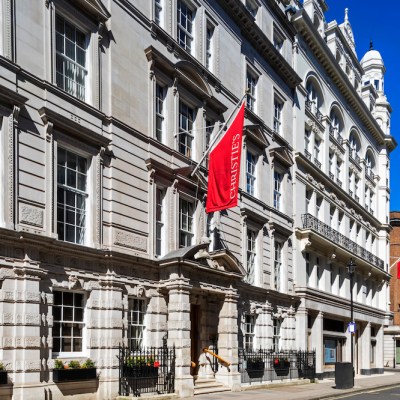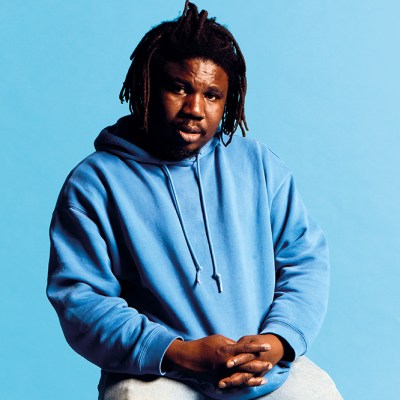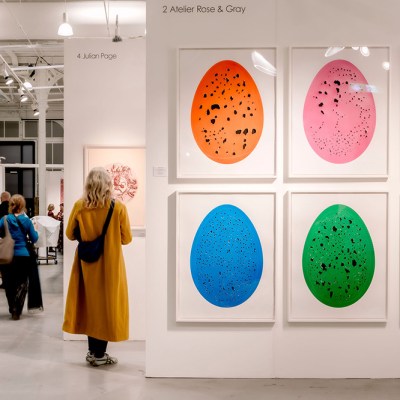

Installation view of ‘the rainbow body’, an exhibition by Ugo Rondinone at Sadie Coles in which coloured figurative sculptures were dotted around a specially painted gallery. Photo: Linda Nylind; courtesy London Gallery Weekend; © Ugo Rondinone
From the July/August 2025 issue of Apollo. Preview and subscribe here.
Charles Saatchi was a genius of spin. He famously packaged a disparate group of young art school graduates as the Young British Artists in the early ’90s and kicked off the idea of London as the art world’s ‘capital of cool’. Not all his boosterism was so effective (his New Neurotic Realism ‘movement’ being a case in point).
His daughter Phoebe appears to be a chip off the old block. Last month Saatchi Yates, the swanky gallery she launched with her husband in 2020, announced its own version of the Summer Exhibition called ‘London Rules the World’. The bill includes artists such as Lucian Freud and Francis Bacon, several YBAs, as well as younger artists who have made the city their home, including Alvaro Barrington and Olaolu Slawn.
The title might have induced a wince or two, since the last time London ruled the world, or a large part of it, was at the height of the British Empire. In the art world, meanwhile, there has been a sense, if anything, of London’s diminution since 2014 when Putin invaded Crimea and wealthy Russians started leaving. Brexit, the pandemic, government cuts to the arts and an increasingly unfriendly tax environment for the UK’s non-dom population, many of whom buy art, have only made matters worse. Which is possibly why the name was hastily changed just before opening last month to ‘Once Upon a Time in London’ (until 17 August).
Phoebe Saatchi Yates is not, however, backing down on her main premise. In a statement, she noted that ‘since opening, all we have heard is London being surpassed by Paris, Milan and Dubai. We wanted to celebrate London’s history, from the modern British giants to younger artists [showing] how through wars, recessions, the pandemic and Brexit, [the city’s] artists continue to triumph.’
She may have a point. Last month the fifth edition of London Gallery Weekend (LGW), which took place from 6–8 June, provided an opportunity to survey what 127 of the capital’s best contemporary art galleries have to offer. And it seems that reports of London’s demise have been greatly exaggerated.
Garden Flower 1, WC (2023) by Alvaro Barrington – one of the works exhibited in ‘Once Upon a Time in London’ at Saatchi Yates. Courtesy Saatchi Yates; © Alvaro Barrington
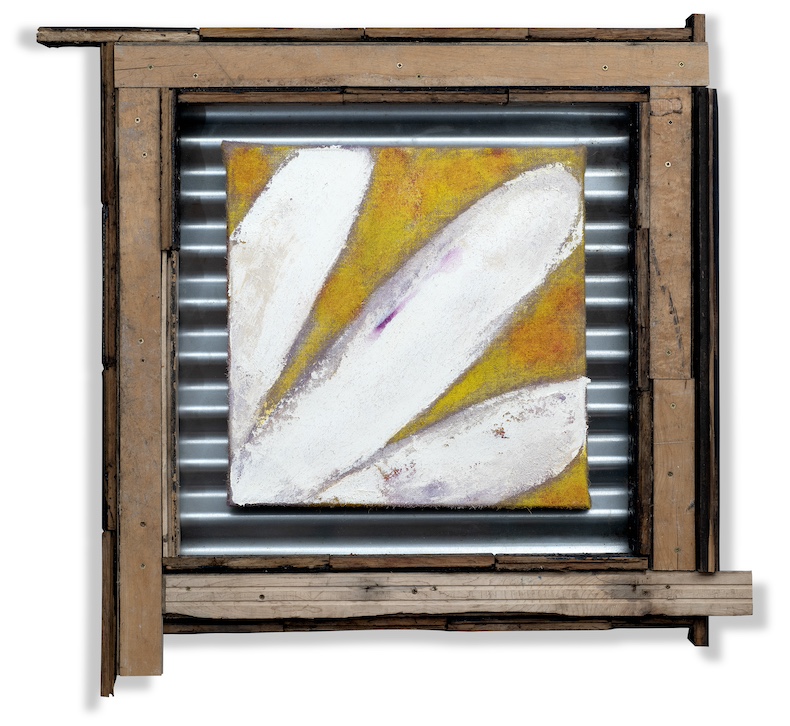
LGW was a product of the pandemic when galleries, led by Edel Assanti, decided to pull together to encourage visitors to return. Major galleries, including David Zwirner, Gagosian, Hauser & Wirth and White Cube, took part this year.
Pace, anticipating the exhibition of the Aboriginal painter Emily Kam Kngwarray at Tate Modern (10 July–11 January 2026), mounted a show of her works with artists she influenced (‘My Country’, until 8 August). Thaddaeus Ropac paired figurative paintings by David Salle, a star of 1980s New York, with three new works by African American painter Jordan Casteel, best known for her portraits of friends and family in Harlem.
Lisson – at nearly 60 years old, one of London’s longest-standing galleries – invited the Egyptian-born, Sharjah-based curator Omar Kholeif to mount a group show of 30 artists (‘Finding My Blue Sky’, until 26 July). The idea, Kholeif says, was to trace relationships between artists as apparently diverse as Sean Scully, Lubaina Himid and Laure Prouvost, who have connections with each other and the city. ‘It’s a series of love letters to the artists and to London,’ Kholeif says. ‘It has brought me back to a place that, no matter how hard it is to stay in, is a true artists’ city.’
Eva Langret, the French-born director of Frieze Europe, the Middle East and Africa, says that she left Paris in 2005 ‘because London felt like a place that made space for new voices, for people starting things up from all around the world’. Despite ‘the self-inflicted wound of Brexit’, she says ‘that spirit has remained’.
Frieze was showing artists represented by three Indian galleries – Chemould Prescott Road, Jhaveri Contemporary and Vadehra Art Gallery – at its No. 9 Cork Street exhibition space. ‘The weekend also highlights how many artists are still managing to live and make work here,’ says Langret, pointing to Michaela Yearwood-Dan (Hauser & Wirth, until 2 August) and Gala Porras-Kim (Sprüth Magers, until 26 July), an American artist of Colombian and Korean heritage who now divides her time between Los Angeles and London.
The artist Rae-Yen Song pictured at her recent exhibition at William Hine, one of the youngest galleries to have taken part in London Gallery Weekend this year. Photo: Linda Nylind; courtesy London Gallery Weekend
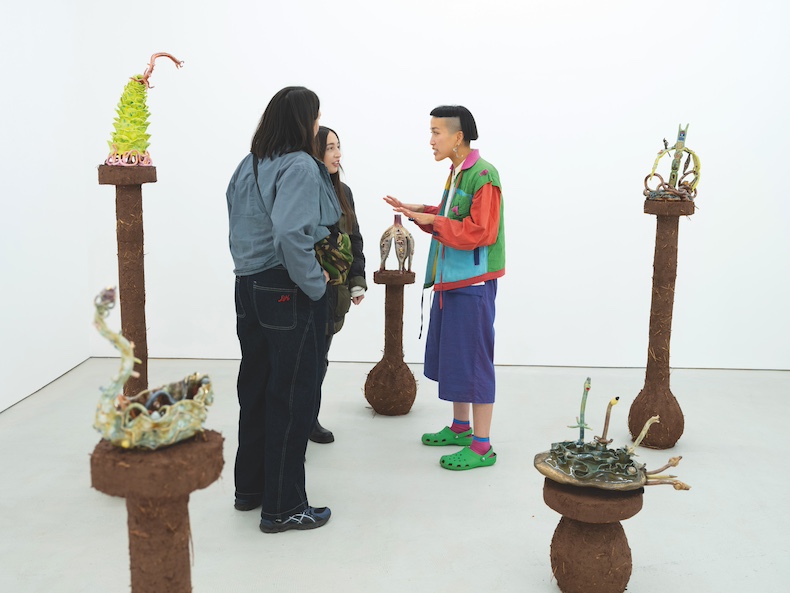
Perhaps the most notable aspect was just how many galleries taking part opened in the past two years. Albion Jeune, Alice Amati, Alma Pearl, Haricot Gallery, Ilenia, Lbf Contemporary and Kearsey & Gold all launched in 2023, Larkin Durey (formerly Jack Bell Gallery), Palmer Gallery and William Hine in 2024 and SLQS in February this year. These were joined by at least 10 others who have moved to bigger, more central galleries or added second spaces since 2023.
Hector Campbell founded Soup in Elephant and Castle in 2023. ‘There’s lots of artists, big studios, great galleries, art schools and institutions in South London,’ he says. The choice of location is also pragmatic. ‘We have more flexibility to mix commercial shows with experimental and conceptual work if we keep our overheads low,’ he says – a strategy several of the smaller galleries are adopting.
The gallery’s exhibition was called ‘Silly Bitch’ – textile sculptures by British-Zimbabwean artist Tulani Hlalo drawing on a colourful mixture of dog grooming and her experience as a gymnast. Campbell says that the opening of a number of other emerging galleries – such as Soft Opening and Ginny on Frederick – since 2018 was an inspiration: ‘The fact that there’s been a bit of a “baby gallery boom” makes it feel like things are possible.’ And he says it is working. ‘Our lower prices mean we have attracted a young collector base, a lot of them first-timers.’
Isaac Simon opened South Parade in Deptford in 2020 and moved to a larger, more central space in Farringdon last summer. It was showing an exhibition by the mid-career artist Judith Dean. Simon says that galleries are taking advantage of lower rents to get a foot on the ladder. ‘It’s giving people a chance to start with low overheads, test the programme and find out if what you are doing is interesting to collectors, curators and art fairs. If that starts to add up you can look at taking a chance of moving to a more central space,’ he says.
Other new galleries, some not part of LGW, have backing allowing them to start out in the centre. Tache opened in March with funding from tech entrepreneur Lawrence Smith. ‘London comes with a unique set of barriers, but it has great art schools. So the gallery was set up as a way to give emerging artists a bridge between art school and making a career in the city,’ says gallery manager Lauren Fulcher.
Based in Fitzrovia, Tache highlights how rapidly the geography of the gallery scene is changing. After the financial crash of 2008 there was a steady move away from trendy but grungy areas like east London. Galleries retreated to traditional districts such as Mayfair and St James’s, believing that international collectors would not travel beyond them.
Installation view of Tulani Hlalo’s exhibition ‘Silly Bitch’, which took place at Soup in Elephant and Castle during London Gallery Weekend. Photo: Peter Otto; courtesy Tulani Hlalo/Soup; © Tulani Hlalo

Fitzrovia has been buzzing since the pandemic: some 20 galleries based there were part of LGW this year. Shoreditch, written off by some once White Cube left Hoxton Square in 2012, has also revived. Around 10 galleries are based within a few streets of each other, including Emalin and Maureen Paley’s second space. They print their own local gallery map and coordinate openings to encourage visitors to explore the area.
‘Since we started, Fitzrovia and Deptford were areas to focus on. Now there’s a new crop of galleries in Bloomsbury doing exciting things,’ says Sarah Rustin, co-director of LGW and director of communications and content at Thaddaeus Ropac.
This trend will be boosted by the opening of a new non-profit project space in October in a Grade I-listed townhouse in Bedford Square. Yan Du Projects (YDP) will present exhibitions by Asian and Asian diaspora artists in the main building and host residencies for emerging artists in the former coach house.
Yan Du, an art collector and philanthropist who moved to London four years ago, describes the new space as ‘a bridge between Asian and diaspora artists, my background and the public here. The audiences here are knowledgeable and open-minded, and I trust they will appreciate what we are doing.’
Bloomsbury was part of the attraction. ‘There are lots of galleries here, and in east London, with interesting gallery programmes that include Asian artists, and the Paul Mellon Centre and Architecture Association are also close by,’ Du says. ‘There is a community here that we want to be part of.’
Overseas galleries have also continued to open in London. The best known is run by French gallerist Emmanuel Perrotin, who launched a space in Claridge’s earlier this year. Others have appeared in the last couple of years, including Ames Yavuz, Bernheim, Berntson Bhattacharjee, Bluerider ART and Upsilon Gallery. Ab-Anbar, originally established in Tehran in 2014, opened in Fitzrovia at the end of 2023. It shows politically oriented art by a mix of Western, Latin American and Middle Eastern diaspora artists. ‘Moving to London created international exposure for art that is often seen in isolation: we’ve had a great reception here,’ says Azadeh Zaferani, one of the co-founders.
Installation view of ‘Augustas Serapinas: Potatoes and Chamomile’ at Emalin, London. Photo: Linda Nylind; courtesy London Gallery Weekend
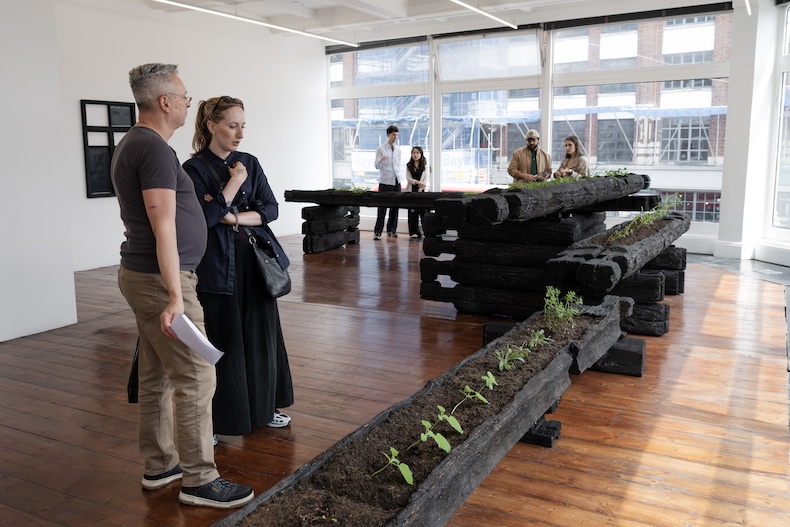
Ab-Anbar will soon be joined by Istanbul’s Dirimart, which shows a mixture of well-known regional and international artists. Founded in 2002, it will open its first gallery abroad in Hanover Square in September. Levent Özmen, senior gallery director, said the gallery had considered the move for several years. Brexit was a blow, he admits, ‘but we think London is bouncing back faster than we expected. So we decided to ignore the hype – new fairs being announced or reports of fast-growing markets. London has a lot of arts institutions with high visitor numbers, arts professionals and critics. There is a public that is focused on art and is curious to learn more,’ he says.
Maria Bernheim opened her gallery in Zurich in 2015 and in London in 2023 with a programme that focuses on young and mid-career artists. ‘Zurich is an incredible base for us – there are so many collectors, museums, even banks who buy art and support Swiss artists,’ she says. ‘But we wanted to be in a world city, and the only one in Europe is London. There are Parisian collectors but they are more conservative – here we have young, curious collectors and every opening is packed.’
But she says red tape and new taxes on the wealthy are making everyone’s work harder. ‘The regulations around things like money laundering are, if anything, getting worse,’ she says. ‘You want to do creative shows, you want to invite people from all over the world, and sometimes it almost feels impossible.’ This did not stop Bernheim showing an ambitious exhibition of sculptures and sculptural paintings by US artist Eli Ping in her elegant four-storey Mayfair gallery for LGW. ‘We are definitely making this work,’ she says.
The same more experimental spirit seems to have infected galleries at all levels – conjuring up the heady days of the 1990s. Herald St in Bethnal Green displayed an installation by Michael Dean, covering the floor in 1,000 misshapen plastic dice. Emalin made the most of its Holywell Lane gallery with a single, striking blackened wood structure with tiny growing plants by Augustas Serapinas (until 26 July). In Savile Row, Hauser & Wirth turned one of its spaces into an arthouse cinema, showing videos by artists including David Hammons and Camille Henrot (until 2 August). Sadie Coles had the walls and floor of her Kingly Street gallery painted in Day-Glo red, green and yellow to show multicoloured casts of dancers by Ugo Rondinone.
Coles explains that the decision to do something show-stopping at London Gallery Weekend ‘is still new but it’s already a very significant event for London, so it’s important for us to put on something that adds to the wonders that people can see over the weekend’. She says that although many high-net-worth individuals have left the city for the likes of Milan and Monaco for tax reasons, ‘many have kept properties here and you see them at events like this. And you never know. London is London, it’s a great city to live in. I hope we’ll see many them back when they get bored of wherever they have moved to.’
Installation view of ‘the rainbow body’, an exhibition by Ugo Rondinone at Sadie Coles in which coloured figurative sculptures were dotted around a specially painted gallery. Photo: Linda Nylind; courtesy London Gallery Weekend; © Ugo Rondinone
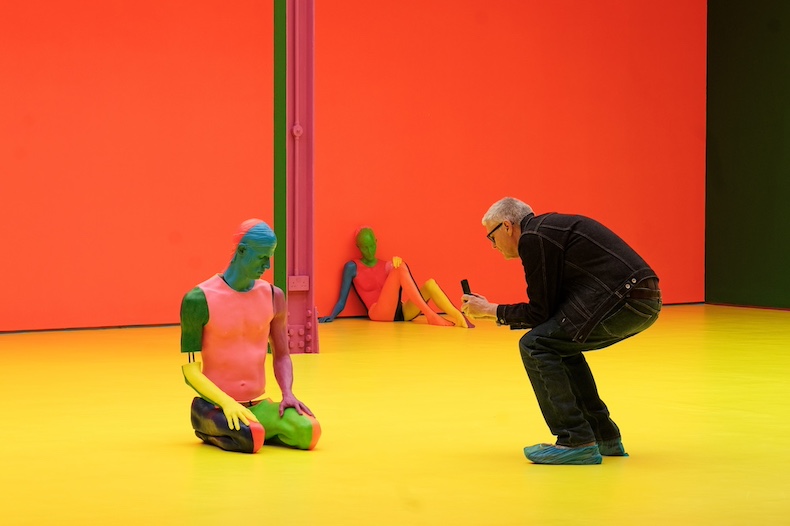
Coles’s Davies St space is now shut, but she will shortly open in a new six-storey Georgian house near Hauser & Wirth. Both are close to Pilar Corrias’s Conduit Street gallery, which saw a steady flow of collectors, museum directors, critics and enthusiasts for Philippe Parreno’s latest project, El Amendral, a huge screen apparently showing a meditative video – in fact, a live feed cutting between cameras in a wild landscape in Almeria.
Corrias opened its big white-cube space at the end of 2023, keeping another London space close by. ‘You need a very strong relationship with the artist and the space,’ she says. ‘That’s why I focus on London rather than attempting to translate that to multiple cities abroad.’ She says she has always welcomed the city’s collegiate spirit since she first set up in a small space in 2008. ‘New York is very competitive. Here there’s much more of community […] We are people who work with artists and help them to make the projects they are dreaming of. And that’s the ethos of a primary gallery, or at least it should be.’
The London art market still faces challenges. According to the last Art Basel UBS survey, it shrank by 5 per cent last year – although the UK regained its status as the second biggest market in the world, behind the United States (which fell by 10 per cent) after bigger falls in China (31 per cent).
At the upper end, at auction (the only publicly visible indicator) sales of works over $10m fell by 23 per cent in 2023 and a further 5 per cent in 2024 – and while this affects New York the most, London has been affected too. Uncertainty over Trump’s on-off tariffs is widespread, while government changes to non-dom status have led to an exodus of millionaires – 10 per cent of the total, according to analysis published in the Financial Times.
But London Gallery Weekend showed what a huge amount of art is on offer at all levels. The top end may have been hit but major galleries still put on ambitious shows. And the emerging scene is thriving. London may not rule the world and it is a bit down – but it is certainly not out.
From the July/August 2025 issue of Apollo. Preview and subscribe here.
